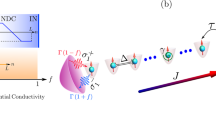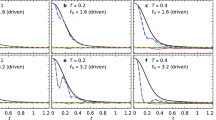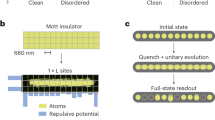Abstract
Linear response theory lies at the heart of studying quantum matters, because it connects the dynamical response of a quantum system to an external probe to correlation functions of the unprobed equilibrium state. Thanks to linear response theory, various experimental probes can be used for determining equilibrium properties. However, so far, both the unprobed system and the probe operator are limited to Hermitian ones. Here, we develop a non-Hermitian linear response theory that considers the dynamical response of a Hermitian system to a non-Hermitian probe, and we can also relate such a dynamical response to the properties of an unprobed Hermitian system at equilibrium. As an application of our theory, we consider the real-time dynamics of momentum distribution induced by one-body and two-body dissipations. Remarkably, for a critical state with no well-defined quasi-particles, we find that the dynamics are slower than the normal state with well-defined quasi-particles, and our theory provides a model-independent way to extract the critical exponent in the real-time correlation function. We find surprisingly good agreement between our theory and a recent cold atom experiment on the dissipative Bose–Hubbard model. We also propose to further quantitatively verify our theory by performing experiments on dissipative one-dimensional Luttinger liquid.
This is a preview of subscription content, access via your institution
Access options
Access Nature and 54 other Nature Portfolio journals
Get Nature+, our best-value online-access subscription
$29.99 / 30 days
cancel any time
Subscribe to this journal
Receive 12 print issues and online access
$209.00 per year
only $17.42 per issue
Buy this article
- Purchase on Springer Link
- Instant access to full article PDF
Prices may be subject to local taxes which are calculated during checkout



Similar content being viewed by others
Data availability
All the data that support the plots within this paper and other findings of this study are available from the corresponding author upon reasonable request.
References
Mahan, G. D. Many Particle Physics (Plenum Press, 1981).
Bouganne, R., Aguilera, M. B., Ghermaoui, A., Beugnon, J. & Gerbier, F. Anomalous decay of coherence in a dissipative many-body system. Nat. Phys. 16, 21–25 (2020).
Syassen, N. et al. Strong dissipation inhibits losses and induces correlations in cold molecular gases. Science 320, 1329–1331 (2008).
Barontini, G. et al. Controlling the dynamics of an open many-body quantum system with localized dissipation. Phys. Rev. Lett. 110, 035302 (2013).
Tomita, T., Nakajima, S., Danshita, I., Takasu, Y. & Takahashi, Y. Observation of the Mott insulator to superfluid crossover of a driven-dissipative Bose–Hubbard system. Sci. Adv. 99, e1701513 (2017).
Sponselee, K. et al. Dynamics of ultracold quantum gases in the dissipative Fermi–Hubbard model. Quantum Sci. Technol. 4, 014002 (2018).
Li, J. et al. Observation of parity–time symmetry breaking transitions in a dissipative Floquet system of ultracold atoms. Nat. Commun. 10, 855 (2019).
Tomita, T., Nakajima, S., Takasu, Y. & Takahashi, Y. Dissipative Bose–Hubbard system with intrinsic two-body loss. Phys. Rev. A 99, 031601 (2019).
Lee, T. E. Anomalous edge state in a non-Hermitian lattice. Phys. Rev. Lett. 116, 133903 (2016).
Leykam, D., Bliokh, K. Y., Huang, C., Chong, Y. D. & Nori, F. Edge modes, degeneracies and topological numbers in non-Hermitian systems. Phys. Rev. Lett. 118, 040401 (2017).
Shen, H., Zhen, B. & Fu, L. Topological band theory for non-Hermitian Hamiltonians. Phys. Rev. Lett. 120, 146402 (2018).
Yao, S. & Wang, Z. Edge states and topological invariants of non-Hermitian systems. Phys. Rev. Lett. 121, 086803 (2018).
Kunst, F. K., Edvardsson, E., Budich, J. C. & Bergholtz, E. J. Biorthogonal bulk-boundary correspondence in non-Hermitian systems. Phys. Rev. Lett. 121, 026808 (2018).
Gong, Z. et al. Topological phases of non-Hermitian systems. Phys. Rev. X 8, 031079 (2018).
Chen, Y. & Zhai, H. Hall conductance of a non-Hermitian Chern insulator. Phys. Rev. B 98, 245130 (2018).
Kawabata, K., Shiozaki, K., Ueda, M. & Sato, M. Symmetry and topology in non-Hermitian physics. Phys. Rev. X 9, 041015 (2019).
Lee, C. H. & Thomale, R. Anatomy of skin modes and topology in non-Hermitian systems. Phys. Rev. B 99, 201103 (2019).
Lee, J. Y., Ahn, J., Zhou, H. & Vishwanath, A. Topological correspondence between Hermitian and non-Hermitian systems: anomalous dynamics. Phys. Rev. Lett. 123, 206404 (2019).
Zeuner, J. M. et al. Observation of a topological transition in the bulk of a non-Hermitian system. Phys. Rev. Lett. 115, 040402 (2015).
Zhou, H. et al. Observation of bulk Fermi arc and polarization half charge from paired exceptional points. Science 359, 1009–1012 (2018).
Harari, G. et al. Topological insulator laser: theory. Science 359, eaar4003 (2018).
Bandres, M. A. et al. Topological insulator laser: experiments. Science 359, eaar4005 (2018).
Helbig, T. et al. Observation of bulk boundary correspondence breakdown in topolectrical circuits. Preprint at https://arxiv.org/abs/1907.11562 (2019).
Xiao, L. Non-Hermitian bulk-boundary correspondence in quantum dynamics. Nat. Phys. (2020); https://doi.org/10.1038/s41567-020-0836-6
Sachdev, S. Quantum Phase Transitions (Cambridge Univ. Press, 1999).
Kamenev, A. Field Theory for Non-Equilibrium Systems (Cambridge Univ. Press, 2011).
Pourfath, M.The Non-Equilibrium Green’s Function Method for Nanoscale Device Simulation (ed. Selberherr, S.) (Springer, 2014).
Zinn-Justin, J. Phase Transitions and Renormalisation Group (Oxford Univ. Press, 2007).
Witczak-Krempa, W., Sørensen, E. S. & Sachdev, S. The dynamics of quantum criticality revealed by quantum Monte Carlo and holography. Nat. Phys. 10, 361–366 (2014).
Giamarchi, T. Quantum Physics in One Dimension (Oxford Science, 2004).
Lieb, E. H. & Liniger, W. Exact analysis of an interacting Bose gas. I. The general solution and the ground state. Phys. Rev. 130, 1605–1616 (1963).
Imambekov, A. & Glazman, L. I. Exact exponents of edge singularities in dynamic correlation functions of 1D Bose gas. Phys. Rev. Lett. 100, 206805 (2008).
Acknowledgements
This work is supported by the Beijing Outstanding Young Scientist Program (H.Z.), NSFC grant no. 11734010 (H.Z. and Y.C.), NSFC grant no. 11604225 (Y.C.), MOST grant no. 2016YFA0301600 (H.Z.) and the Beijing Natural Science Foundation (Z180013; Y.C.).
Author information
Authors and Affiliations
Contributions
H.Z. initiated the project. H.Z. and Y.C. led the project. All authors contributed to performing calculations, discussing the results and writing the paper.
Corresponding authors
Ethics declarations
Competing interests
The authors declare no competing interests.
Additional information
Publisher’s note Springer Nature remains neutral with regard to jurisdictional claims in published maps and institutional affiliations.
Supplementary information
Supplementary Information
Supplementary Discussion.
Rights and permissions
About this article
Cite this article
Pan, L., Chen, X., Chen, Y. et al. Non-Hermitian linear response theory. Nat. Phys. 16, 767–771 (2020). https://doi.org/10.1038/s41567-020-0889-6
Received:
Accepted:
Published:
Issue Date:
DOI: https://doi.org/10.1038/s41567-020-0889-6
This article is cited by
-
Perturbative Page curve induced by external impulse
Journal of High Energy Physics (2023)
-
Non-Hermitian skin clusters from strong interactions
Communications Physics (2022)
-
Biorthogonal quantum criticality in non-Hermitian many-body systems
Frontiers of Physics (2022)
-
Entropy linear response theory with non-Markovian bath
Journal of High Energy Physics (2021)
-
Time Evolution of Two-States Non-Hermitian Systems
International Journal of Theoretical Physics (2021)



